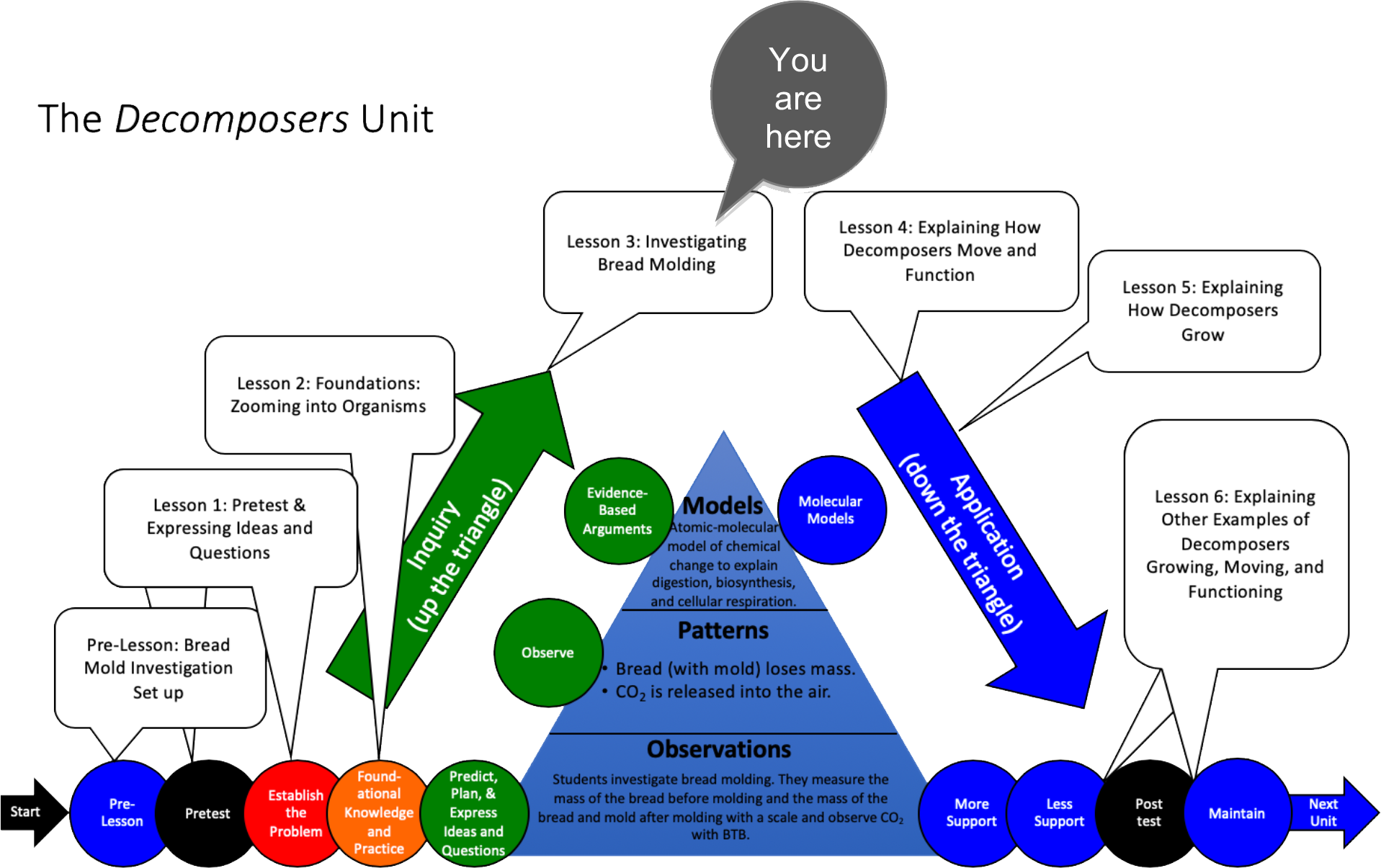Transformations in Matter and Energy Carbon TIME is an NSF-funded partnership led by Michigan State University
Decomposers | Lesson 3 - Investigating Bread Molding
Students conduct an investigation to explore what happens when bread molds. They use two process tools in this lesson to record their ideas: The Predictions and Planning Tool and the Evidence-Based Arguments Tool.
Guiding Question
What happens when bread molds?
Activities in this Lesson
- Activity 3.1: Predictions and Planning about Bread Molding (35 min)
- Activity 3.2: Observing Bread Molding (60 min over 2 days)
- Activity 3.3: Evidence-Based Arguments for Bread Molding (50 min)
Unit Map

Target Performances
|
Activity |
Target Performance |
|
Lesson 3 – Investigating Bread Molding (students as investigators and questioners) |
|
|---|---|
|
Activity 3.1: Predictions and Planning about Bread Molding |
Students (a) develop hypotheses about how matter moves and changes and how energy changes when bread molds and (b) make predictions about how they can use their investigation tools—digital balances and BTB—to detect movements and changes in matter. |
|
Activity 3.2: Observing Bread Molding |
Students record data about changes in mass and BTB when bread molds and reach consensus about patterns in their data. |
|
Activity 3.3: Evidence-Based Arguments for Bread Molding |
Students (a) use data from their investigations to develop evidence-based arguments about how matter moves and changes and how energy changes when bread molds, and (b) identify unanswered questions about matter movement and matter and energy change that the data are insufficient to address. |
NGSS Performance Expectations
High School
- Chemical Reactions. HS-PS1-7. Use mathematical representations to support the claim that atoms, and therefore mass, are conserved during a chemical reaction.
- Matter and Energy in Organisms and Ecosystems. HS-LS1-7. Use a model to illustrate that cellular respiration is a chemical process whereby the bonds of food molecules and oxygen molecules are broken and the bonds in new compounds are formed resulting in a net transfer of energy.
Middle School
- Chemical Reactions. MS-PS1-2. Analyze and interpret data on the properties of substances before and after the substances interact to determine if a chemical reaction has occurred.
Talk and Writing
At this stage in the unit, students will complete the inquiry and application sequences for bread molding—they go both up and down the triangle. This means that they will go through the Predictions and Planning Phase, the Observations Phase, and the Evidence-Based Arguments Phase in one lesson. The tables below show specific talk and writing goals for these phases of the unit.
|
Talk and Writing Goals for the Predictions Phase |
Teacher Talk Strategies That Support This Goal |
Curriculum Components That Support This Goal |
|---|---|---|
|
Treat this as elicitation and brainstorming (like the Expressing Ideas Phase), but with more directed questioning. |
Now that we have set up the investigation, we want to predict what we think will happen to matter and energy. |
Three Questions Handout Predictions and Planning Tool |
|
Elicit a range of student ideas. Press for details. Encourage students to examine, compare, and contrast their ideas with the ideas of other students. |
Who can add to that? What do you mean by _____? Say more. So, I think you said _____. Is that right? Who has a different idea? How are those ideas similar/different? Who can rephrase ________’s idea? |
Investigation Video (first half) |
|
Encourage students to provide evidence that supports their predictions. . |
How do you know that? What have you seen in the world that makes you think that? |
|
|
Have students document their ideas to revisit later. |
Let’s record our ideas so we can come back to them and see how our ideas change. |
Predictions and Planning Tool |
|
Talk and Writing Goals for the Observations Phase |
Teacher Talk Strategies That Support This Goal |
Curriculum Components That Support This Goal |
|---|---|---|
|
Help students discuss data and identify patterns. |
What patterns do we see in our data? How do you know that is a pattern? What about ______ data. What does this mean? |
Class Results Poster Class Results Spreadsheet |
|
Encourage students to compare their own conclusions about the data and evidence with other groups and other classes. |
What about this number? What does this tell us? How is group A’s evidence different from Group B’s data? How do our class’s data differ from other classes’ data? |
Class Results Spreadsheet Class Results Poster Investigation Video (second half). |
|
Make connections between the observations and the data/evidence. |
It says here that our BTB turned colors. What does that mean? You recorded that your bread lost weight. What does that mean? |
Observations Worksheet |
|
Have students consider how their predictions and results compare. |
Let’s revisit our predictions. Who can explain the difference between our class predictions and our results? Who had predictions that were similar to our results? Has your explanation changed? How? |
|

 Download PDF of Lesson 3 Teacher's Guide
Download PDF of Lesson 3 Teacher's Guide